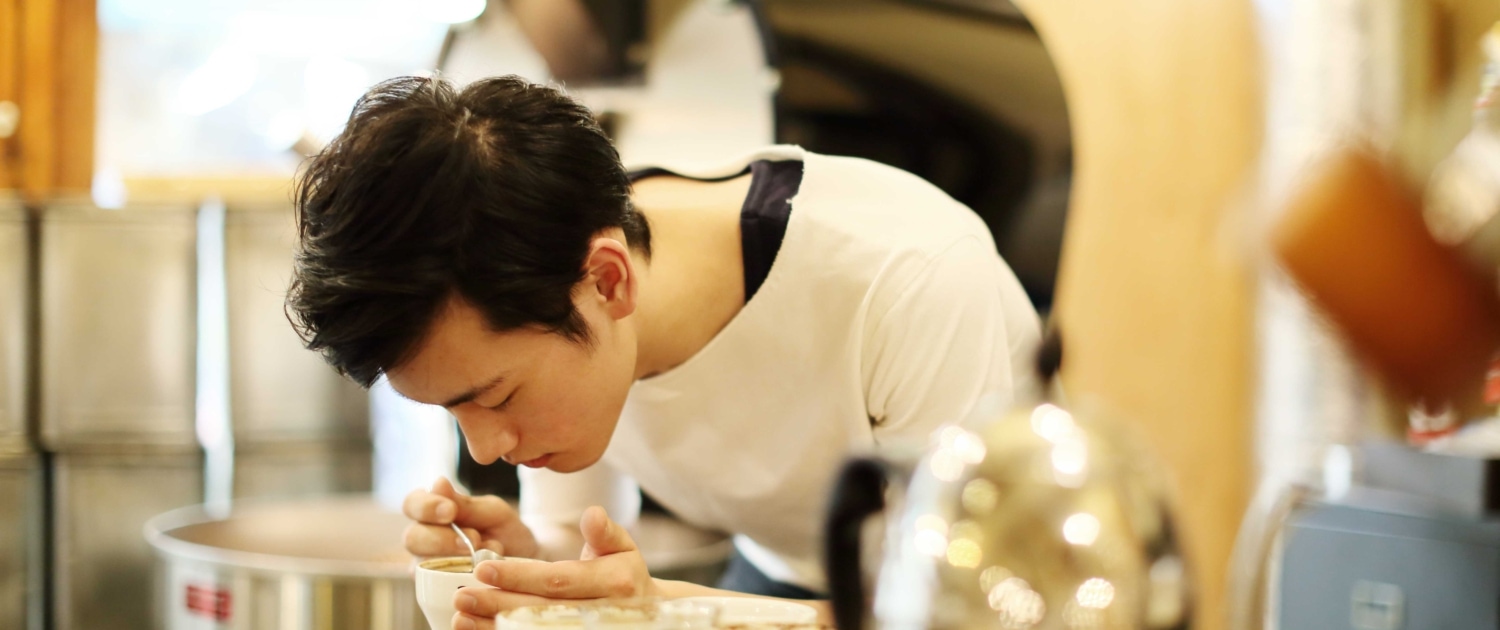Coffee Cupping
– How to Professionally Taste Coffee –
Many people love and appreciate coffee.
I am definitely one of them. Coffee plays a central role in many of our daily lives.
It not only tastes delicious in all of its colorful versions. The empowering dark liquid also provides us with an energy boost whenever we may need it.
On top, coffee comes with many great health benefits. Many people even say that coffee makes them happier and live longer.
But how do we know what makes good coffee or bad coffee? How can we determine the individual taste of each coffee bean type?
The answer is coffee cupping. It is a process to find out about individual coffee qualities, aromas and flavors.
And, I have good news. Anyone can actually do coffee cupping, also you and me at home.
But what exactly is coffee cupping? What are the steps we need to consider?
Here is everything to know how to professionally taste coffee.
Why You Should Try Coffee Cupping
Have you heard of this fancy process, called coffee cupping, already?
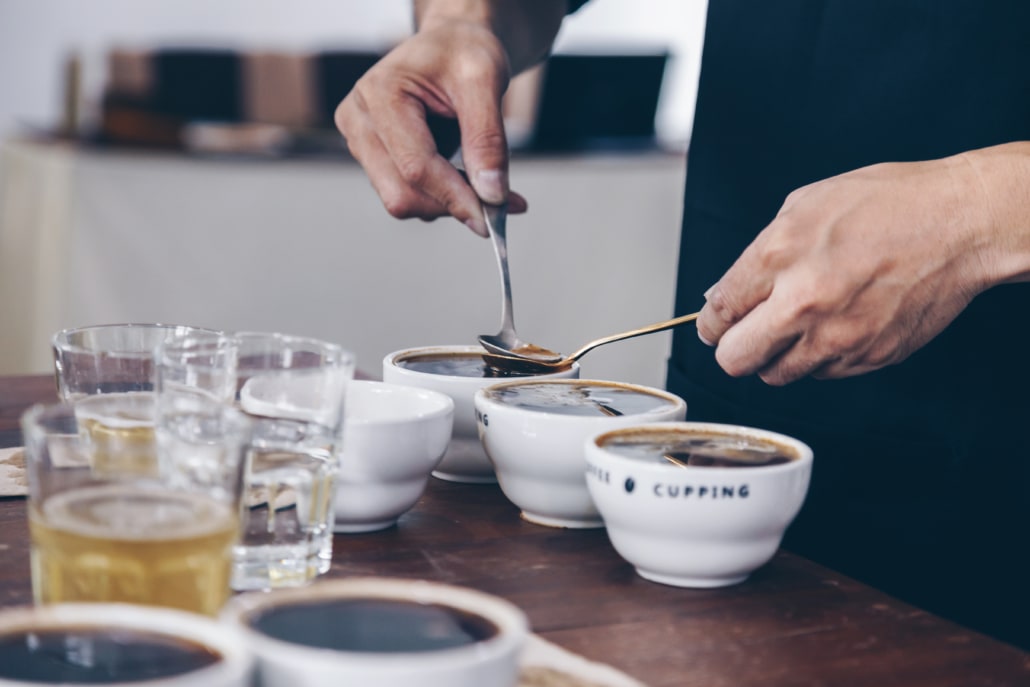
Maybe you are thinking that it is just for the professional, high-end baristas. For the ones, who are skillfully trained and can taste all of the things about coffee.
This is not true.
Yes, high-end cupping can be intensely detailing and even overwhelming sometimes. However, any coffee enthusiast can essentially be part of this exciting coffee tasting experience.
In short, what’s so great about coffee cupping?
It allows all of us coffee lovers to even appreciate our coffee and its origin a bit more. We can follow our fanaticism and passion in new ways.
As a result, we can further increase our coffee knowledge and experience. On top, it’s also quite a fun opportunity to socialize with other like-minded coffee friends.
In order to get it started. There are a few rules and guidelines, however. We should want to keep them in mind. Here is a basic introduction to coffee cupping.
What is Coffee Cupping?
Basically, coffee cupping is an essential part of a general, quality control process. It is eventually concerning every single cup of our daily coffee.
The main goal is to ensure that certain quality is always guaranteed.
Specialists are cupping the coffee at various stages of the coffee supply chain. This is to make sure that the product is possibly as good as it should be.
According to Patriot Coffee Roasters, coffee cupping means the following. It is a way to taste, evaluate, and compare the flavor, quality, and potential of a given coffee.
Typically, people who are pursuing this profession are skilled pros. They can deconstruct and determine particular flavors and aromas to an impressively precise level.
The main goal is to ensure a good product for us consumers. Ideally, every coffee sip should be deep, rich and complex in its full flavor profile.
How to Get Started
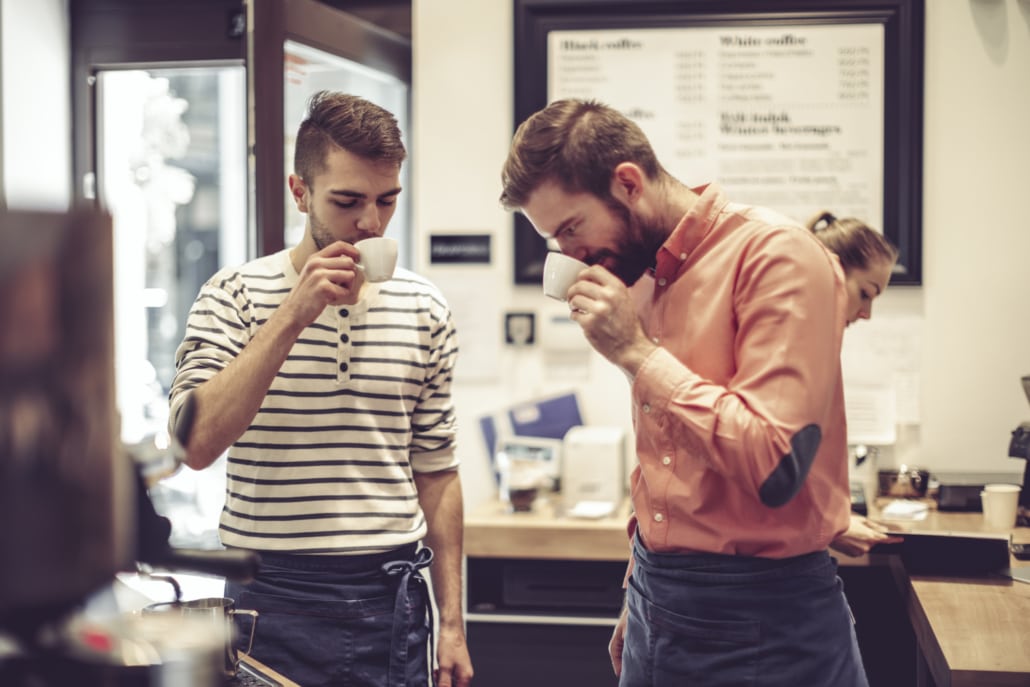
Like with any profession, there can be a million variations and opinions on cupping.
You should try to understand coffee cupping as a fluid process.
Especially when you are trying it at home. Try to enjoy the cupping process and have fun. While being best possibly specific and accurate the same time.
Of course, professional cuppers will look at the entire process very scientifically. In its core, that is not wrong and the right intention.
But, don’t misunderstand, that we coffee enthusiasts can still be become part of the action as well.
Overall, that’s maybe the best thing about coffee cupping. There is no real right or wrong answer.
Nonetheless, with the additional knowledge you can acquire through coffee cupping. Eventually, you can actually learn how to brew and acknowledge a good cup of coffee.
This article will share the most common coffee cupping method with you. We also like to use it ourselves.
However, please keep in mind that cupping methods may differ. There may be some slight differences from one cupping tutorial to the next.
But, that is actually not an issue.
Essentially, when it comes to proper coffee cupping, consistency is key.
Once you have selected a certain method, you should better stick to it. Maybe, you can make some minor variations on your own. But the basics should always stay the same.
Because, in case you are changing any methods. This means that any previously collected data on cupped coffees is less reliable and useful then.
To sum up, you certainly need stability in your method.
Then, you can make sure that you are genuinely comparing each coffee.
The Fundamentals of Cupping Coffee
Here is a quick overview of the 6 major points to consider when cupping coffee.
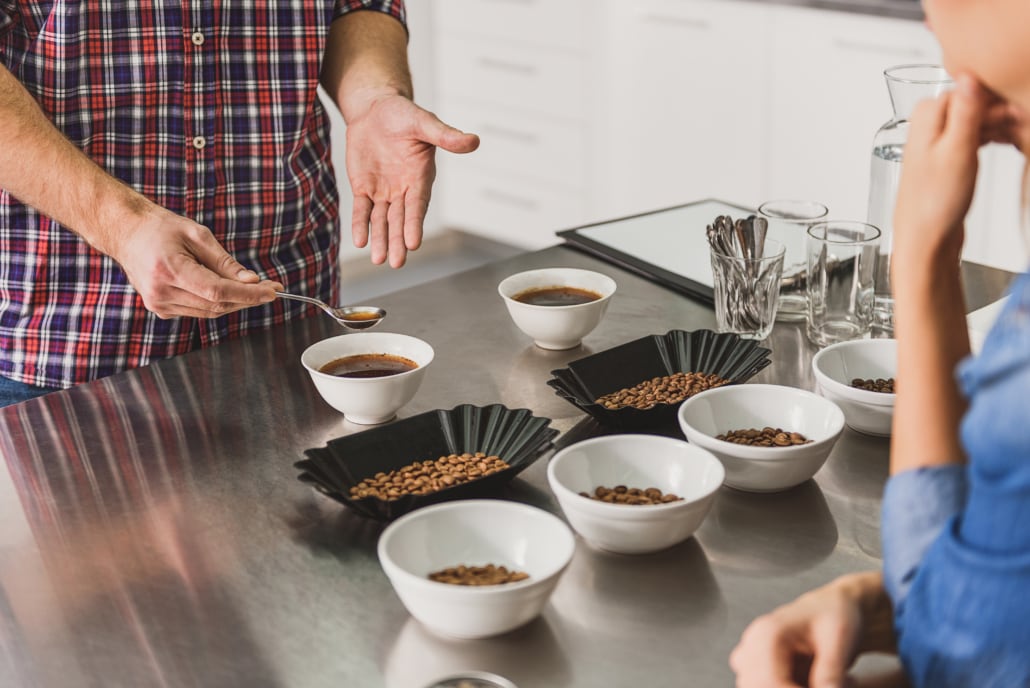
These points include items such as the type of beans to use, for example. Essentially, we can ask ourselves following two questions.
What main factors are involved in the cupping coffee method? And, how do we properly judge the coffee itself then?
-
Coffee Beans And Roast Types
Types of Beans
As first important step, you will want to choose single origin beans.
These beans are only coming from one specific coffee growing region. This is the entire point of coffee cupping.
It is the goal to explore and compare the differences between coffee beans that are grown in different places.
Roast Type
Next, you will also want to use lightly roasted coffee beans. This would simply be best.
Medium roasts may also work. But, it is typically not recommended to use them. However, you should definitely not choose to work with dark roasted beans.
Most of the flavor characteristics of coffee beans tend to diminish, the darker the roast level gets.
When it comes to coffee cupping and roast levels, the general assumption is following. Namely, that the roasting process competes with the flavor and aroma of the beans themselves.
Level by level, it simply becomes more challenging to detect the original flavor.
In addition, please also make sure that the beans are ideally freshly roasted.
It is quite important to use fresher beans. The best ones are no more than two weeks out from the roast date.
-
Ratio
For our purposes, we will be using the official coffee cupping ratio.
The suggestion comes from the Specialty Coffee Association. And, it is 8.25 grams for every 150ml of water.
This is what we will be using here. But, as mentioned already, the exact ratio amounts and guidelines may vary from tutorial to the next.
It is not very important which ratio amounts you are eventually using. Just remember to always stay consistent and stick to your final choices.
-
Grind Size
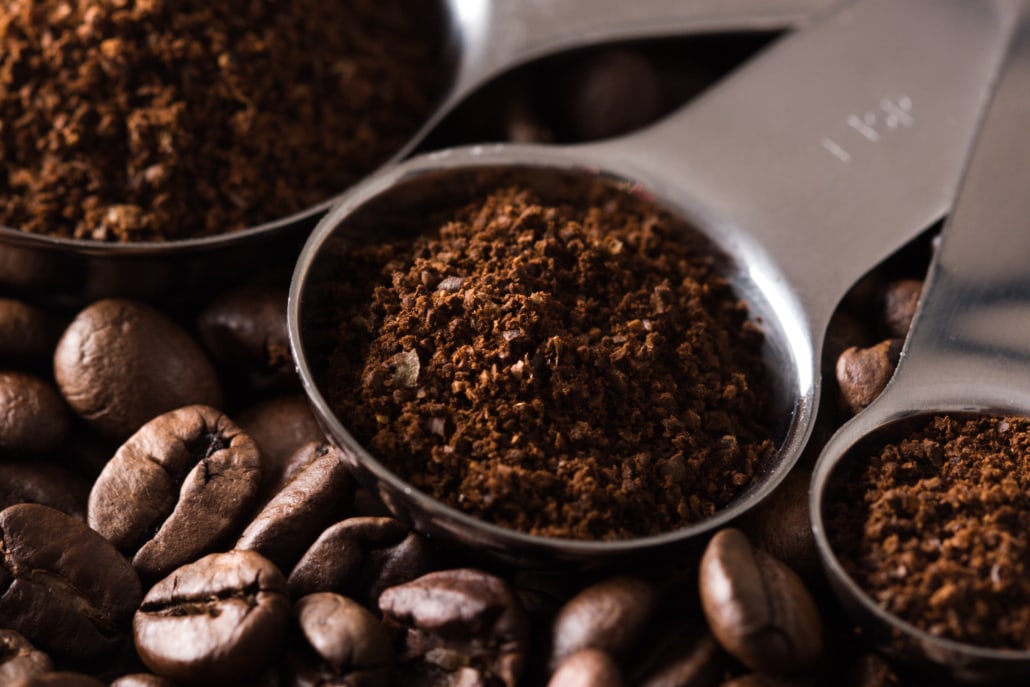
We are recommending you to use a burr grinder.
This enables you to efficiently grind the beans to a medium-coarsed grind. Such grind size typically works the best for the process of coffee cupping.
-
Priming The Grinder
Regarding the grinder machine itself, there is one more point I would like to make you aware.
Every time you are using your grinder. Some residual coffee grounds get left behind in the grind chamber.
Now, normally, this is not a big issue. There is no problem if a few residual grounds are sneaking into your next grind and brew.
But since we are aiming to exercise proper coffee cupping. This becomes quite important. Ideally, we don’t even want a miniscule amount of ‘foreign flavor’ affect our cupping.
So, how can we avoid this to happen?
We are priming our grinder!
And, that’s how it’s done. Before grinding the actual beans, you are already throwing a small batch of the same beans you are about to grind in to the grinder, first.
Grind these first beans up and put them aside. Now, your grinder will have leftovers of the same coffee type you are actually planning to use.
You are good to move forward, now. And, this step of priming can be repeated over and over again.
-
Use Good Water
Here comes another important step for us to keep in mind.
In general, we should always use good water with our coffee. Try not to use distilled water. It might influence the extraction and flavoring.
If possible, work with some well-filtered water. Overall, you should always work with the same type of water.
Then, any own, potential water flavors cannot temper with your coffee cupping results too much.
-
Tasting Techniques And Terminology
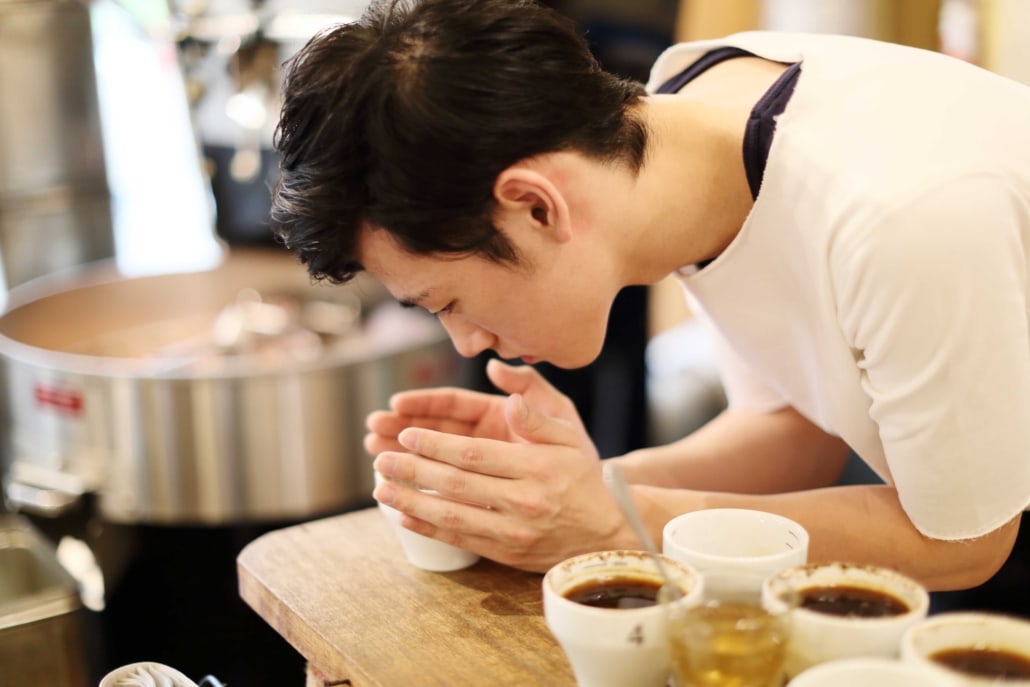
When you will be cupping coffee. There will always be some obvious and stronger flavor notes of coffee beans to stand out.
In general, these obvious flavor characteristics are much easier to detect.
But there are also those that are more subtle and difficult to notice. You can say that these are hiding more in the background.
Try to make it part of your mission to discover these ones as well.
While you are cupping coffee. You will be taking the time to smell and taste the coffee types in several different ways.
Here is a quick overview of common practices to do.
- Evaluate the dry aroma
- Evaluate the wet aroma (This will happen twice. Before and after breaking the top coffee layer ‘crust’)
- Evaluate the taste itself (This is including several subcategories.)
- Body (Is the body full, rich etc.?)
- Depth & Complexity (What are the various flavors themselves?)
- Acidity (For example, does the acidity add liveliness or taste sour?)
- Finish (What is the aftertaste like?)
Additional Helpful Tools For Coffee Cupping
In order to better structure and standardize your coffee cupping process. There are a few supporting tools I would like to recommend you to implement them into your work process as well.
As a start, the coffee tasting note templates can be very helpful to make records. They assist you keeping your focus and direction during the moments of tasting.
For example, the cupping form from the Specialty Coffee Association is quite handy.
You can find many other and similar cupping forms online. Most of them are easy to download. And, many are even available in different language. Just choose what seems most suitable for you.
Additionally, you should also try using a coffee flavor wheel. It gives you a great oversight of many terms and categorizations.

Again, you can easily find downloadable coffee flavor wheels online. They can be of great of help for you. Especially when you are trying to name specific flavors while you are tasting coffee.
It is not always to find and pinpoint the exact term. So, this will definitely assist you greatly.
Nonetheless, try not to overcomplicate things when you are just starting for coffee cupping. Maybe you just focus on what you naturally notice.
Flavor wheels or specialized tasting sheets can also follow at later stages. When you already feel more comfortable with the entire process of coffee cupping.
So How to Cup Coffee in Practice?
Okay, enough theory. Let’s get started, shall we?
Step by step, we will go over how to cup coffee.
Firstly, find yourself a comfortable and convenient tasting area and good cupping table. Often, roundtables work well, if several people are tasting and interchanging the same time.
Get all of your supplies and don’t forget to have fun!
What do I Need?
Here is a short list of recommended items to gather.
- Prepare two or more freshly roasted, single origin coffee types
- Gather two small bowls for each coffee you are using
- Get a good burr grinder
- Bring a scale to measure amounts
- A kettle is necessary to boil water
- Grab a bunch of cupping spoons (at least one per person)
- Add a tall glass
- Find a clear and good cupping form online (this item is optional and only recommended)
- Also choose a good flavor wheel (this item is also optional and only recommended)
- Bring a laptop, tablet, or pen and paper to take notes
- Ask a friend or two to join your coffee cupping adventure!
The Method of Coffee Cupping
Here are the 9 major steps to set up and practice cupping coffee for you.
Of course, as I mentioned a few times already. The entire process should also be fun. However, certain parts need to be done in order and in a timely manner.
Otherwise, you may compromise the coffee. And, this would make the cupping process more difficult.
In addition, here is also a great instruction video for you to watch.
-
Setting Everything Up
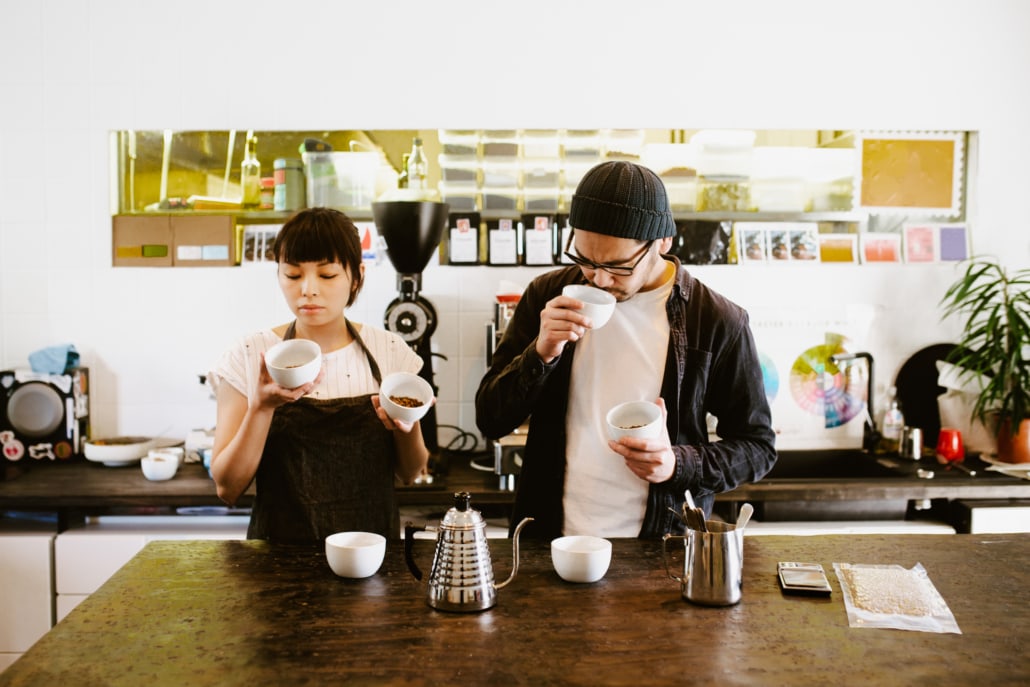
As first step, you can place a bowl on the table. Use a separate bowl for each coffee you are planning to cup.
Furthermore, go ahead and label each bowl. Don’t use the actual names or origin of the coffee beans. You want everything to be unbiased and neutral.
Ideally, you should not make any pre-assumptions or judgements regarding any coffee types and names. Some of them you might know before already.
Next, place your spoons in the tall glass nearby.
Either grab your laptop or a pen and paper. Prepare your coffee tasting notes station as well.
-
Heating The Water
Let’s move on to our kettle and fill it up with plenty of water. Eventually, you should have 150 ml of water per coffee.
After the water is boiling, wait for another 60 seconds. Then, you can add it to the coffee.
It would be good to have a thermometer nearby as well. This way, you can regularly check the temperature. Try to keep it between 90 to 95 degrees Celcius (195-205 degrees Fahrenheit).
-
Preparing The Coffee Beans
While the water is boiling, you can already go over to the next step.
Weigh out each kind of your coffee bean types into two portions. The first one is the 4 gram ‘priming’ batch. And, the second bowl contains the actual sample amount of 8.25 grams.
Eventually, you should have two piles for every coffee bean type.
-
Priming And Grinding Your Coffee Samples
We already discussed the process and reason of priming earlier.
So, as next step, we are taking each 4 gram pile of coffee and prime our grinder with it. After, we set those grinds aside and grind our 8.25 gram sample right after.
When finished, we place our second batch (8.25 gram sample) of ground coffee back into its bowl. And, we place the bowl with its label back to its original tasting spot on the table.
In total, we are repeating the same steps with every coffee type we are choosing to cup.
Furthermore, the Specialty Coffee Association is recommending that any sample should ideally be ground immediately prior to our coffee cupping.
If we are able to, it should not be more than 15 minutes before the infusion with water.
Moreover, in case that’s not possible. We should try to keep our sample sizes covered and infused not more than 30 minutes after grinding.
However, this is only a suggestion. For some of us, it might be impossible to exactly follow the time window.
-
Smelling The Grounds
At this point, we actually get to the first ‘real’ part of our coffee cupping experience.
For this, you are smelling the coffee grounds. Open your mouth. And, take a gently but also firm sniff of each coffee sample. Try to breathe both through your mouth and nose.
Some people prefer to close their eyes while smelling. It can help to focus more on your olfactory senses.
You should completely ‘immerse’ yourself into the smell. So, please get really close to your bowl. During this step, it is the dry aroma you are trying to get a sense of.
Go ahead and take notes of everything you experience.
Ask yourself. What are you detecting and smelling? Do you notice any hints of cinnamon, lavender, orange or nuts maybe?
You don’t need to worry too much about your initial terminology. Feel free to use unconventional words if that helps you to specify the description you need.
Sometimes, the smell can bring up certain memories, for example. Follow your sensory imagination and write everything down.
-
Adding The Hot Water
Now, we are getting to the water.
But, please remember. We want our water to be hot and not boiling. Once your water is ready, pour about 150 grams into your bowl of coffee grounds.
By the way, also fill up your tall glass as well then. This is where you are storing your tasting spoons and keep them clean.
-
Smelling It Again
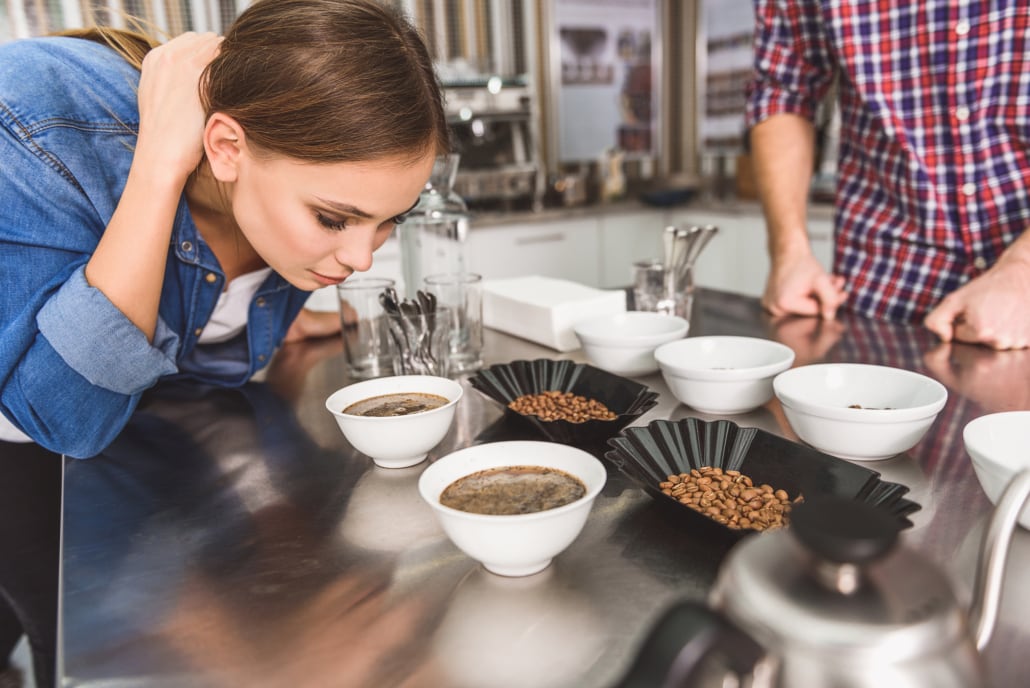
With the hot water in our sample bowls, we are ready to smell each coffee sample again.
Don’t be shy and get close again. Lean right over your bowl. Open your mouth and inhale in a slow and controlled way.
What did you smell this time? Take notes again.
Did you notice any differences from the dry aroma smell experience before?
-
Breaking The ‘Crust’ And Smelling One More Time
Okay, onto our next step.
After we added our hot water 3 or 4 minutes earlier already. On the top of your bowl, you will witness a nice, thick layer developing.
These floating coffee grounds and bubbles are called the ‘crust’.
Grab two of your warmed up cupping spoons out of the tall glass. Use them to gently ‘break the crust’. Push the floating grounds out of the middle of the bowl and to the sides.
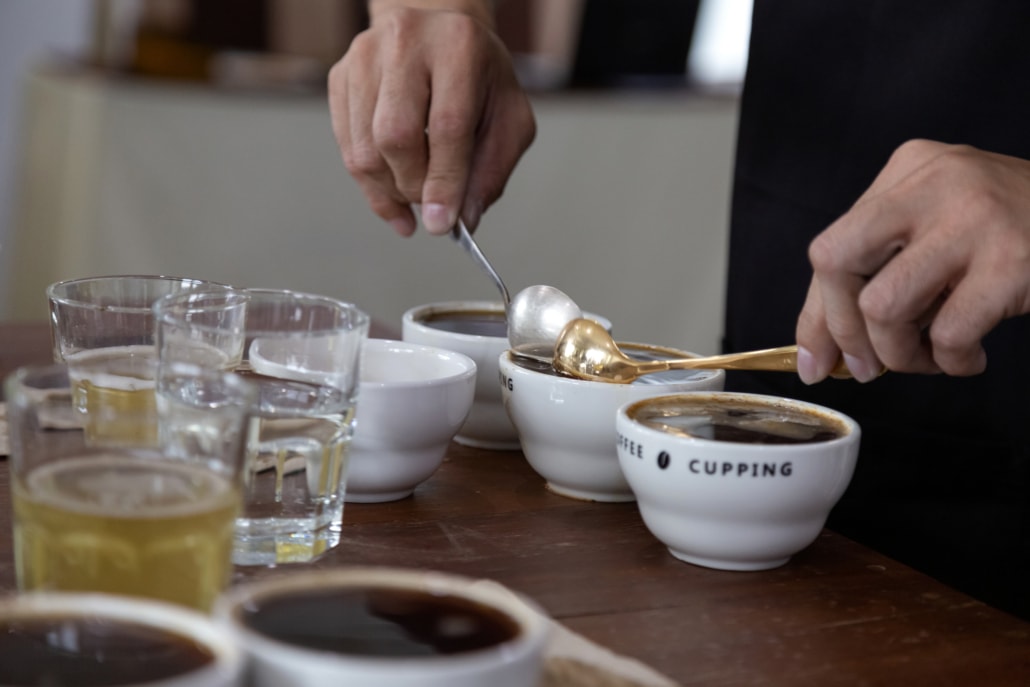
Again, open your mouth and take a deep breath.
The smell you just experienced is commonly considered the closest introduction you are going to get to the actual taste of the coffee itself.
Please continue to ‘break the crust’ with all of your samples. And, don’t forget to take notes, of course.
Always make sure to put your spoon back into the tall glass between each sample tasting, as well. This is to not contaminate the sample tastes with each other.
After you have ‘broken the crust’ and smelled each sample bowl. Gently stir the top of each coffee with a clean spoon.
This will break up the top a bit more. As a result, more of the grounds will sink to the bottom of your bowl.
Eventually, scoop all of the remaining crust away.
-
Tasting The Coffee
Welcome to the final step. We can also consider it to be the stage of ‘true taste-testing’.
Firstly, go ahead and take a clean spoon out of your tall glass again. Scoop a spoonful of coffee right out of the center of your bowl.
Ideally, try to avoid getting any coffee grounds on your spoon.
Secondly, gently sip the coffee. It should hit both the roof of your mouth and your tongue on the way to the back of your mouth.
Keep it in your mouth for a moment. Move it around. And then, you can either swallow or spit it out.
Take your time and really focus on the flavor notes you just experienced.
Again, write everything down as best as you can.
Congratulations, you just completed your first round of full coffee cupping.
Follow up Questions
Below, we share some the most frequently asked questions and their answers with you.
What Are The Main Steps of Coffee Cupping?
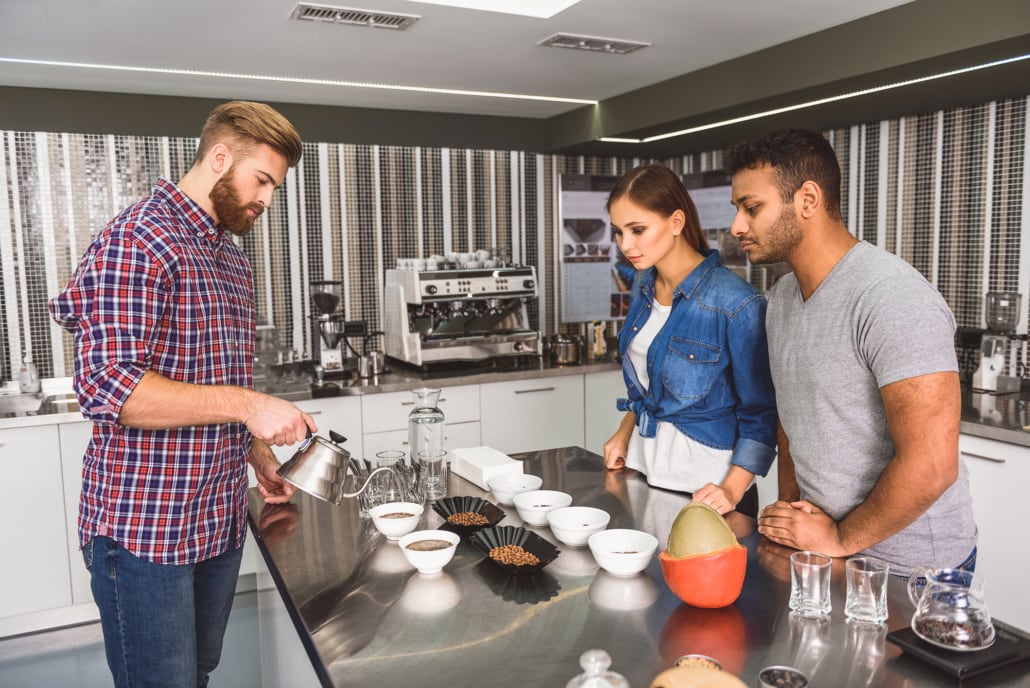
Typically, coffee is all about its various aromas and flavors.
In order to properly detect these, there are essentially four main stages in the process. The first two steps would involve smelling the coffee. This is before and after you added the water.
And, the other one would be the actual tasting of the coffee. Of course, this would take place after you added the water and allowed it to brew.
Furthermore, you are taking your time to smell and taste the coffee accordingly. Lastly then, you will need to detect, understand and describe the smells and flavors.
In short, the four main stages are smelling, tasting, understanding and describing.
What is Best Coffee in Tastes?
There is no real, definitive right or wrong answer here.
It all depends on each one of us and our individual preferences. Generally, it is almost impossible to say that there is only one single coffee that might objectively dominate all of the others.
In fact, there are many deliciously tasting types of for us to explore out there.
Maybe that’s the entire beauty of our vast coffee universe. We can all find creative and unique ways to express ourselves, if we wish.
Can I Make Good Tasting Coffee at Home?
Of course, you can.
As we just highlighted, coffee is a very versatile product. There are many different and interesting ways to make good coffee at home.
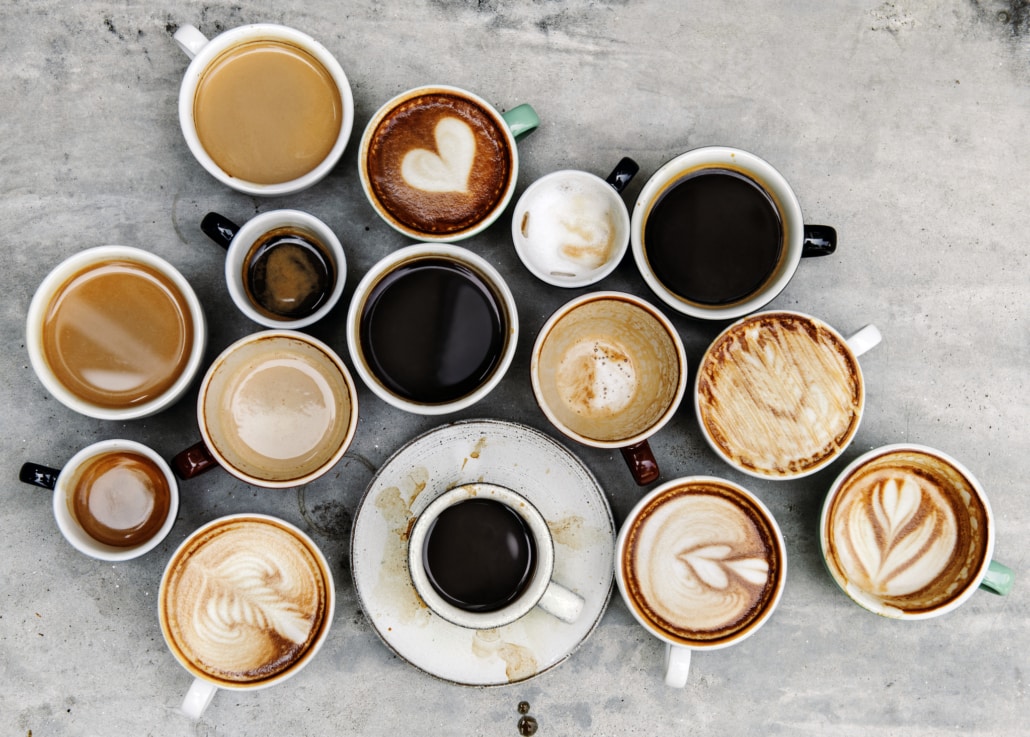
For example, you can make coffee using an espresso machine. Other exciting methods include the French press, Aeropress and a Stovetop Moka Pot. The list goes on and on.
Each method can provide you with a uniquely tasting coffee. This is because each preparation extracts the soluble coffee material in different ways.
Nonetheless, there should at least be one consistent factor. In order to make good coffee, you should always brew between 90 to 95 degrees Celcius (195-205 degrees Fahrenheit).
Try not to over- or under-extract your coffee. And, you can enjoy best aromas and flavors by using freshly ground beans.
What Can I Add to Make my Coffee Taste Better?
Commonly, most people tend to either add some regular sugar or milk. Or even both, as in many cases.
Especially the ingredient, milk, has become a major player in our modern coffee culture. There are various milk-based coffee creations we appreciate.
These include drinks like lattes, cappuccinos and flat whites, for example.
By the way, another great addition is butter. Yes, you have heard right. In fact, butter coffee does not just taste amazingly different. It also comes with some great health benefits.
Last but not least, many coffee lovers do ‘sweeten’ or ‘milk up’ their coffee. But they would maybe like do it in a more health-conscious way.
Nowadays, there is great variety of non-dairy products and alternative sweeteners available.
Final Thoughts – Coffee Cupping
In my own opinion, there is one most important aspect regarding cupping coffee.
While we should approach the process seriously and best possibly in a professional way. We should also not forget to enjoy and have fun the same time.
Coffee cupping gives us a great opportunity to further expand our coffee knowledge. It enables us to explore and experience new aromas and flavors.
So, how about you?
Did you try coffee cupping yourself already? What are the main steps in your opinion? Is there anything we should maybe be aware of?
Feel free to share your coffee cupping experiences with us.
Until then, stay healthy, safe and properly caffeinated.
Cheers!
Related Posts
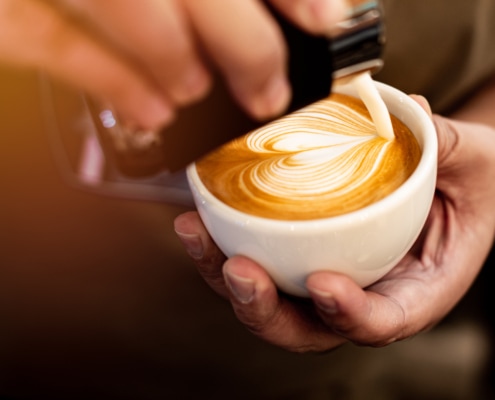 https://www.siamhillscoffee.com/wp-content/uploads/Is-Latte-Art-Good-or-Bad-–-Does-Latte-Art-Make-our-Coffee-Better-or-Worse-–-1.jpg
1412
2122
Siamhillscoffee
https://www.siamhillscoffee.com/wp-content/uploads/coffee-logo.png
Siamhillscoffee2021-04-25 10:57:092021-04-25 11:02:29Is Latte Art Good or Bad? – Does Latte Art Make our Coffee Better or Worse? –
https://www.siamhillscoffee.com/wp-content/uploads/Is-Latte-Art-Good-or-Bad-–-Does-Latte-Art-Make-our-Coffee-Better-or-Worse-–-1.jpg
1412
2122
Siamhillscoffee
https://www.siamhillscoffee.com/wp-content/uploads/coffee-logo.png
Siamhillscoffee2021-04-25 10:57:092021-04-25 11:02:29Is Latte Art Good or Bad? – Does Latte Art Make our Coffee Better or Worse? –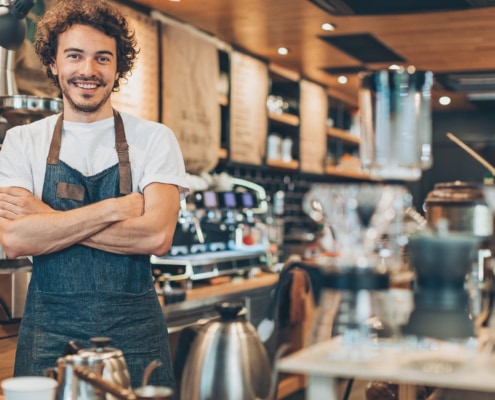 https://www.siamhillscoffee.com/wp-content/uploads/How-To-Open-A-Coffee-Shop-The-Coffee-Shop-Equipment-List-You-Need-1.jpg
1414
2121
Siamhillscoffee
https://www.siamhillscoffee.com/wp-content/uploads/coffee-logo.png
Siamhillscoffee2021-03-21 04:08:192021-03-21 04:08:19How To Open A Coffee Shop – The Coffee Shop Equipment List You Need
https://www.siamhillscoffee.com/wp-content/uploads/How-To-Open-A-Coffee-Shop-The-Coffee-Shop-Equipment-List-You-Need-1.jpg
1414
2121
Siamhillscoffee
https://www.siamhillscoffee.com/wp-content/uploads/coffee-logo.png
Siamhillscoffee2021-03-21 04:08:192021-03-21 04:08:19How To Open A Coffee Shop – The Coffee Shop Equipment List You Need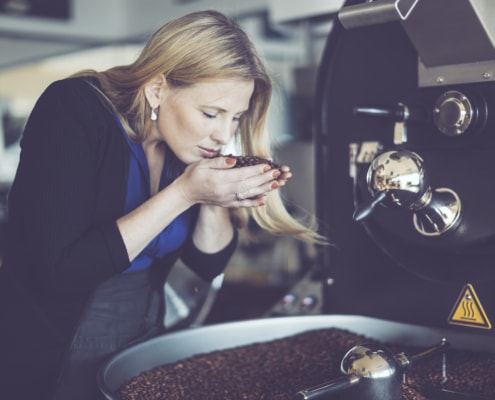 https://www.siamhillscoffee.com/wp-content/uploads/What-is-Coffee-Roasting-–-Everything-You-Need-to-Know-–-1.jpg
1414
2121
Siamhillscoffee
https://www.siamhillscoffee.com/wp-content/uploads/coffee-logo.png
Siamhillscoffee2021-02-20 05:19:592021-03-03 10:49:15What is Coffee Roasting? – Everything You Need to Know –
https://www.siamhillscoffee.com/wp-content/uploads/What-is-Coffee-Roasting-–-Everything-You-Need-to-Know-–-1.jpg
1414
2121
Siamhillscoffee
https://www.siamhillscoffee.com/wp-content/uploads/coffee-logo.png
Siamhillscoffee2021-02-20 05:19:592021-03-03 10:49:15What is Coffee Roasting? – Everything You Need to Know –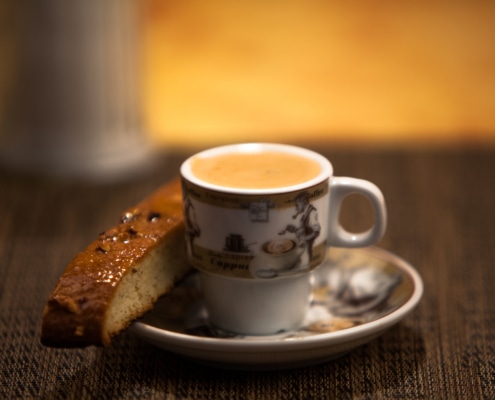 https://www.siamhillscoffee.com/wp-content/uploads/What-is-a-Cafe-Cubano-–-A-Complete-Guide-–-1.jpg
1414
2121
Siamhillscoffee
https://www.siamhillscoffee.com/wp-content/uploads/coffee-logo.png
Siamhillscoffee2021-02-20 04:57:432021-03-03 10:54:47What is a Cafe Cubano – A Complete Guide –
https://www.siamhillscoffee.com/wp-content/uploads/What-is-a-Cafe-Cubano-–-A-Complete-Guide-–-1.jpg
1414
2121
Siamhillscoffee
https://www.siamhillscoffee.com/wp-content/uploads/coffee-logo.png
Siamhillscoffee2021-02-20 04:57:432021-03-03 10:54:47What is a Cafe Cubano – A Complete Guide – https://www.siamhillscoffee.com/wp-content/uploads/Make-Your-Coffee-Healthy-–-Best-10-Ways-For-A-Better-Coffee-Experience-–-1.jpg
1414
2121
Siamhillscoffee
https://www.siamhillscoffee.com/wp-content/uploads/coffee-logo.png
Siamhillscoffee2021-02-12 08:13:182021-03-03 10:57:16Make Your Coffee Healthy – Best 10 Ways For A Better Coffee Experience –
https://www.siamhillscoffee.com/wp-content/uploads/Make-Your-Coffee-Healthy-–-Best-10-Ways-For-A-Better-Coffee-Experience-–-1.jpg
1414
2121
Siamhillscoffee
https://www.siamhillscoffee.com/wp-content/uploads/coffee-logo.png
Siamhillscoffee2021-02-12 08:13:182021-03-03 10:57:16Make Your Coffee Healthy – Best 10 Ways For A Better Coffee Experience – https://www.siamhillscoffee.com/wp-content/uploads/10-Best-Ways-to-Eat-Less-Sugar-–-How-to-Cut-Down-on-Sugar-–-1-scaled.jpg
1709
2560
Siamhillscoffee
https://www.siamhillscoffee.com/wp-content/uploads/coffee-logo.png
Siamhillscoffee2021-02-12 08:07:142021-03-03 10:58:4810 Best Ways to Eat Less Sugar – How to Cut Down on Sugar –
https://www.siamhillscoffee.com/wp-content/uploads/10-Best-Ways-to-Eat-Less-Sugar-–-How-to-Cut-Down-on-Sugar-–-1-scaled.jpg
1709
2560
Siamhillscoffee
https://www.siamhillscoffee.com/wp-content/uploads/coffee-logo.png
Siamhillscoffee2021-02-12 08:07:142021-03-03 10:58:4810 Best Ways to Eat Less Sugar – How to Cut Down on Sugar –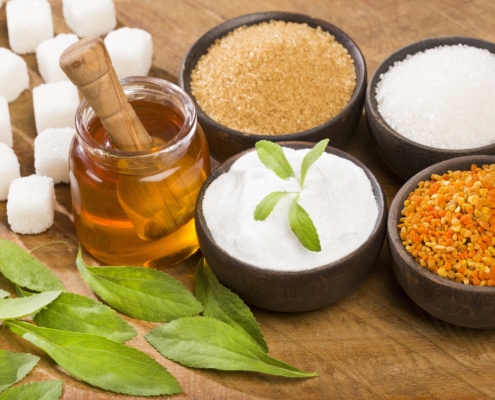 https://www.siamhillscoffee.com/wp-content/uploads/10-Best-Natural-Sugar-Substitutes-–-Your-Healthier-Sugar-Alternatives-to-Try-–-1-scaled.jpg
1707
2560
Siamhillscoffee
https://www.siamhillscoffee.com/wp-content/uploads/coffee-logo.png
Siamhillscoffee2021-02-12 07:32:372021-03-03 11:08:1810 Best Natural Sugar Substitutes – Your Healthier Sugar Alternatives to Try –
https://www.siamhillscoffee.com/wp-content/uploads/10-Best-Natural-Sugar-Substitutes-–-Your-Healthier-Sugar-Alternatives-to-Try-–-1-scaled.jpg
1707
2560
Siamhillscoffee
https://www.siamhillscoffee.com/wp-content/uploads/coffee-logo.png
Siamhillscoffee2021-02-12 07:32:372021-03-03 11:08:1810 Best Natural Sugar Substitutes – Your Healthier Sugar Alternatives to Try –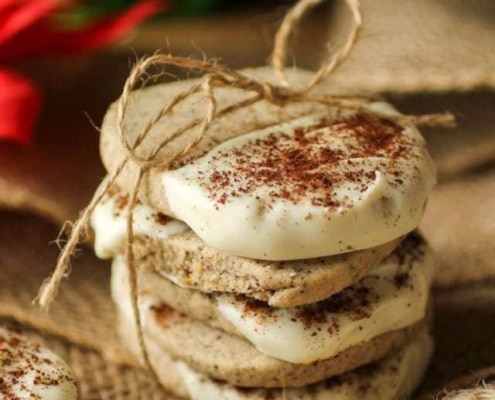 https://www.siamhillscoffee.com/wp-content/uploads/20-Best-Ground-Coffee-Recipes-9.jpg
896
640
Siamhillscoffee
https://www.siamhillscoffee.com/wp-content/uploads/coffee-logo.png
Siamhillscoffee2021-02-12 07:10:502021-03-03 11:14:2220 Best Ground Coffee Recipes – Make Delicious Food With Coffee –
https://www.siamhillscoffee.com/wp-content/uploads/20-Best-Ground-Coffee-Recipes-9.jpg
896
640
Siamhillscoffee
https://www.siamhillscoffee.com/wp-content/uploads/coffee-logo.png
Siamhillscoffee2021-02-12 07:10:502021-03-03 11:14:2220 Best Ground Coffee Recipes – Make Delicious Food With Coffee –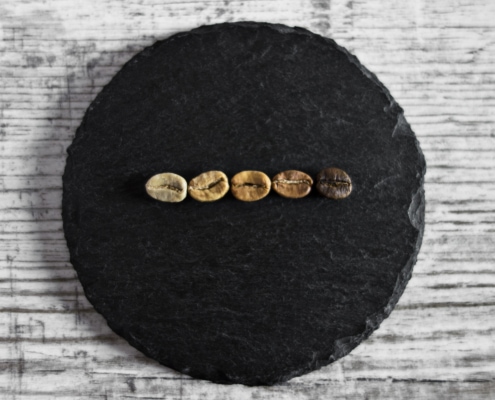 https://www.siamhillscoffee.com/wp-content/uploads/Coffee-Roast-Levels-1-scaled.jpg
1707
2560
Siamhillscoffee
https://www.siamhillscoffee.com/wp-content/uploads/coffee-logo.png
Siamhillscoffee2021-02-12 06:58:112021-03-03 11:44:54Coffee Roast Levels – The Differences Between Light, Medium and Dark Roasts –
https://www.siamhillscoffee.com/wp-content/uploads/Coffee-Roast-Levels-1-scaled.jpg
1707
2560
Siamhillscoffee
https://www.siamhillscoffee.com/wp-content/uploads/coffee-logo.png
Siamhillscoffee2021-02-12 06:58:112021-03-03 11:44:54Coffee Roast Levels – The Differences Between Light, Medium and Dark Roasts –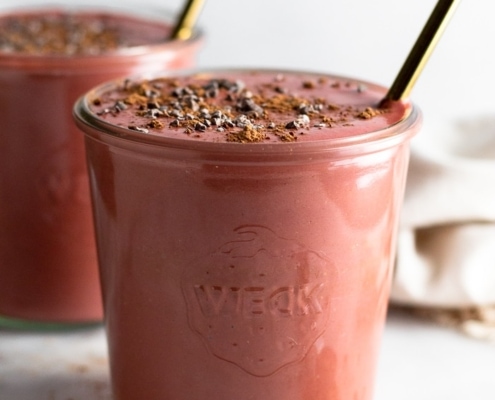 https://www.siamhillscoffee.com/wp-content/uploads/15-Great-Coffee-Breakfast-Smoothies-–-Simply-Delicious-Ways-to-Boost-Your-Morning-–14.jpg
1050
700
Siamhillscoffee
https://www.siamhillscoffee.com/wp-content/uploads/coffee-logo.png
Siamhillscoffee2021-02-12 06:52:492021-03-03 11:46:4615 Great Coffee Breakfast Smoothies – Delicious Ways to Boost Your Morning –
https://www.siamhillscoffee.com/wp-content/uploads/15-Great-Coffee-Breakfast-Smoothies-–-Simply-Delicious-Ways-to-Boost-Your-Morning-–14.jpg
1050
700
Siamhillscoffee
https://www.siamhillscoffee.com/wp-content/uploads/coffee-logo.png
Siamhillscoffee2021-02-12 06:52:492021-03-03 11:46:4615 Great Coffee Breakfast Smoothies – Delicious Ways to Boost Your Morning –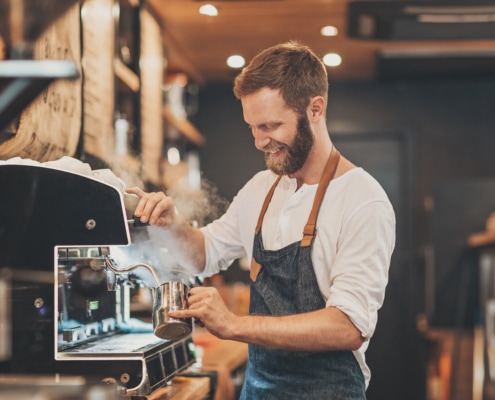 https://www.siamhillscoffee.com/wp-content/uploads/What-is-a-Barista-–-How-to-Professionally-Make-Coffee-–-1-scaled.jpg
1707
2560
Siamhillscoffee
https://www.siamhillscoffee.com/wp-content/uploads/coffee-logo.png
Siamhillscoffee2021-02-12 05:15:182021-03-03 12:02:08What is a Barista? – How to Professionally Make Coffee –
https://www.siamhillscoffee.com/wp-content/uploads/What-is-a-Barista-–-How-to-Professionally-Make-Coffee-–-1-scaled.jpg
1707
2560
Siamhillscoffee
https://www.siamhillscoffee.com/wp-content/uploads/coffee-logo.png
Siamhillscoffee2021-02-12 05:15:182021-03-03 12:02:08What is a Barista? – How to Professionally Make Coffee –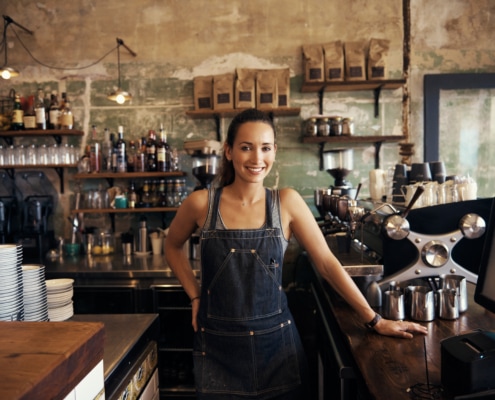 https://www.siamhillscoffee.com/wp-content/uploads/How-To-Open-A-Coffee-Shop-The-10-Most-Important-Steps-1-scaled.jpg
1708
2560
Siamhillscoffee
https://www.siamhillscoffee.com/wp-content/uploads/coffee-logo.png
Siamhillscoffee2021-02-12 04:37:232021-03-03 12:10:33How To Open A Coffee Shop – The 10 Most Important Steps
https://www.siamhillscoffee.com/wp-content/uploads/How-To-Open-A-Coffee-Shop-The-10-Most-Important-Steps-1-scaled.jpg
1708
2560
Siamhillscoffee
https://www.siamhillscoffee.com/wp-content/uploads/coffee-logo.png
Siamhillscoffee2021-02-12 04:37:232021-03-03 12:10:33How To Open A Coffee Shop – The 10 Most Important Steps https://www.siamhillscoffee.com/wp-content/uploads/How-To-Sell-Coffee-Online-–-Open-Your-Own-Online-Coffee-Shop-1-scaled.jpg
1697
2560
Siamhillscoffee
https://www.siamhillscoffee.com/wp-content/uploads/coffee-logo.png
Siamhillscoffee2021-02-12 04:32:292021-03-03 12:12:06How To Sell Coffee Online – Open Your Own Online Coffee Shop
https://www.siamhillscoffee.com/wp-content/uploads/How-To-Sell-Coffee-Online-–-Open-Your-Own-Online-Coffee-Shop-1-scaled.jpg
1697
2560
Siamhillscoffee
https://www.siamhillscoffee.com/wp-content/uploads/coffee-logo.png
Siamhillscoffee2021-02-12 04:32:292021-03-03 12:12:06How To Sell Coffee Online – Open Your Own Online Coffee Shop https://www.siamhillscoffee.com/wp-content/uploads/Make-Your-Coffee-Better-–-6-Fun-Ways-to-Boost-Your-Coffee-–-1-scaled.jpg
1709
2560
Siamhillscoffee
https://www.siamhillscoffee.com/wp-content/uploads/coffee-logo.png
Siamhillscoffee2021-02-12 03:45:112021-03-03 12:29:07Make Your Coffee Better – 6 Fun Ways to Boost Your Coffee –
https://www.siamhillscoffee.com/wp-content/uploads/Make-Your-Coffee-Better-–-6-Fun-Ways-to-Boost-Your-Coffee-–-1-scaled.jpg
1709
2560
Siamhillscoffee
https://www.siamhillscoffee.com/wp-content/uploads/coffee-logo.png
Siamhillscoffee2021-02-12 03:45:112021-03-03 12:29:07Make Your Coffee Better – 6 Fun Ways to Boost Your Coffee –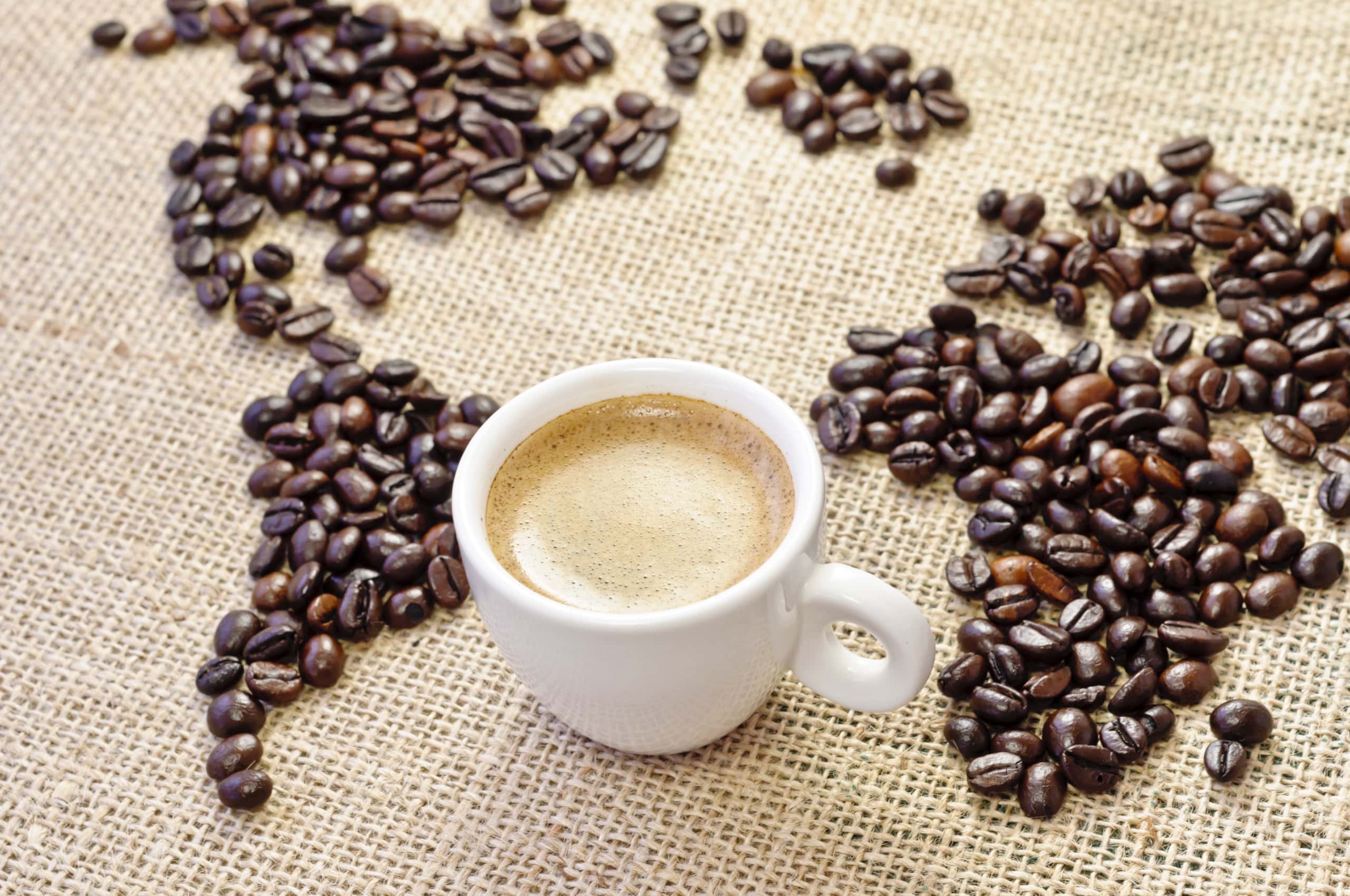 https://www.siamhillscoffee.com/wp-content/uploads/A-Coffee-Journey-–-10-Steps-From-the-Seed-to-Your-Cup-–-1-scaled.jpg
1700
2560
Siamhillscoffee
https://www.siamhillscoffee.com/wp-content/uploads/coffee-logo.png
Siamhillscoffee2021-02-12 02:31:102021-02-20 14:09:30A Coffee Journey – 10 Steps From the Seed to Your Cup –
https://www.siamhillscoffee.com/wp-content/uploads/A-Coffee-Journey-–-10-Steps-From-the-Seed-to-Your-Cup-–-1-scaled.jpg
1700
2560
Siamhillscoffee
https://www.siamhillscoffee.com/wp-content/uploads/coffee-logo.png
Siamhillscoffee2021-02-12 02:31:102021-02-20 14:09:30A Coffee Journey – 10 Steps From the Seed to Your Cup –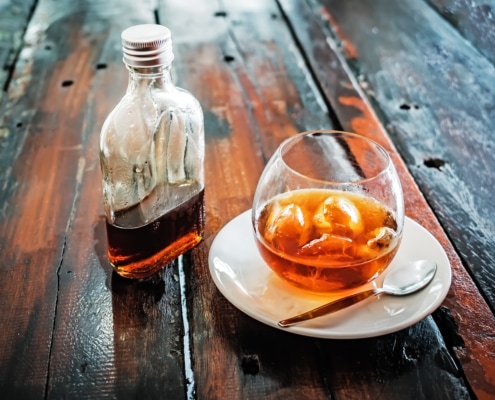 https://www.siamhillscoffee.com/wp-content/uploads/Cold_Brew_Coffee_An_Honest_Opinion_All_You_Need_To_Know_1.jpg
3144
4608
Siamhillscoffee
https://www.siamhillscoffee.com/wp-content/uploads/coffee-logo.png
Siamhillscoffee2019-11-06 05:01:152021-03-03 13:30:17Cold Brew Coffee – An Honest Opinion – All You Need to Know
https://www.siamhillscoffee.com/wp-content/uploads/Cold_Brew_Coffee_An_Honest_Opinion_All_You_Need_To_Know_1.jpg
3144
4608
Siamhillscoffee
https://www.siamhillscoffee.com/wp-content/uploads/coffee-logo.png
Siamhillscoffee2019-11-06 05:01:152021-03-03 13:30:17Cold Brew Coffee – An Honest Opinion – All You Need to Know
